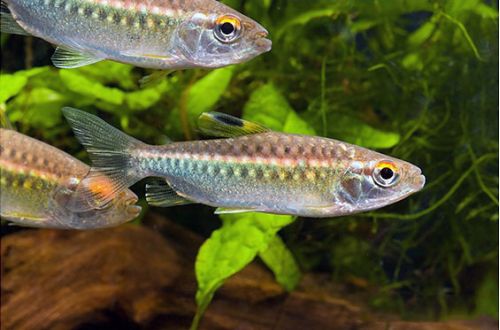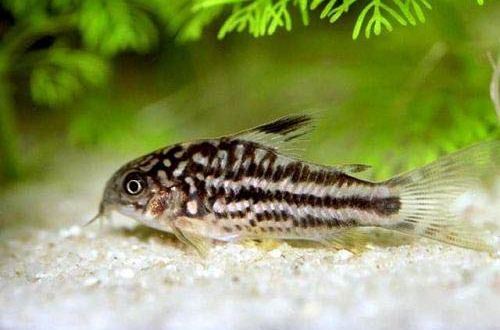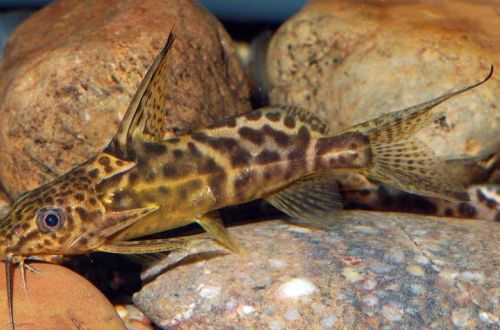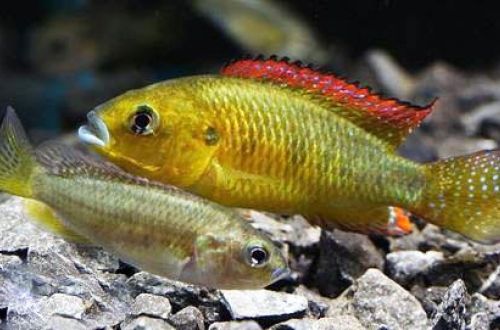
Afriška tetra
The African red-eyed tetra, scientific name Arnoldichthys spilopterus, belongs to the family Alestidae (African tetras). Beautiful very active fish, hardy, easy to keep and breed, in favorable conditions can live up to 10 years.

vsebina
Habitat
Endemic to a small section of the Niger River Basin in Ogun State, Nigeria. Despite its popularity in the aquarium trade, this species is almost never found in the wild due to habitat degradation caused by human activities – pollution, deforestation.
Kratke informacije:
- Prostornina akvarija - od 150 litrov.
- Temperatura – 23-28°C
- Vrednost pH - 6.0-7.0
- Trdota vode – mehka ali srednje trda (1-15 dGH)
- Substrate type – any sandy or small pebble
- Osvetlitev - umirjena, zmerna
- Somornica – ne
- Gibanje vode – nizko/zmerno
- Velikost rib je do 10 cm.
- Hrana - katera koli hrana
- Temperament - miren, zelo aktiven
- Ohranjanje v jati najmanj 6 posameznikov
Opis
Adult individuals reach a length of up to 10 cm. They have a somewhat elongated body with large scales. A wide light horizontal line runs down the middle. The color above the line is gray, below it is yellowish with a blue tint. A characteristic feature is the presence of red pigment in the upper fornix of the eye. Males are more colorful than females.
Hrana
They are not at all pretentious in food, they will accept all types of dry, frozen and live food. A varied diet contributes to the development of better colors and vice versa, a meager monotonous diet, for example, consisting of one type of food, will not be reflected in the best way in the brightness of colors.
Vzdrževanje in nega, ureditev akvarija
For such a mobile fish, a tank of at least 150 liters is required. The design uses sand or small pebbles with some large smooth stones, various driftwood (both decorative and natural) and strong hardy plants. All decorative elements are placed compactly and mainly along the side and back walls of the aquarium to leave enough free space for swimming.
Using a filter with peat-based filter media will help simulate the water conditions of a natural habitat. The hydrochemical composition of water has slightly acidic pH values with low or medium hardness (dGH).
Aquarium maintenance comes down to regular cleaning of the soil from organic waste (food debris and excrement), as well as weekly replacement of part of the water (15–20% of the volume) with fresh water.
Vedenje in združljivost
Peaceful, schooling and extremely active fish, so you should not keep it together with timid sedentary species. Perfectly compatible with Synodontis, Parrotfish, Kribensis and African Tetras of similar size and temperament.
Vzreja / vzreja
In favorable conditions, the chances are high that fry will appear in the general aquarium, but because of the threat of being eaten, they should be transplanted in a timely manner. If you plan to start breeding, then it is recommended to prepare a separate tank for spawning – a spawning aquarium. The design is the simplest, often do without it. In order to protect the eggs, and later the fry, the bottom is covered with a fine-mesh net, or with a thick layer of small-leaved, unpretentious plants or mosses. The lighting is subdued. Of the equipment – a heater and a simple airlift filter.
The stimulus for spawning is a gradual change in water conditions (slightly acidic soft water) and the inclusion of a large amount of protein products in the diet. In other words, live and frozen foods should form the basis of the diet of the African Red-Eyed Tetra. After some time, the females will become noticeably rounded, the coloring of the males will become more intense. This marks the beginning of the mating season. First, several females are transplanted into the spawning aquarium, and the next day, the largest and brightest male.
The end of spawning can be determined by the strongly “thinner” females and the presence of eggs among plants or under a fine mesh. The fish are returned. The fry appear in the next day and already on the 2nd or 3rd day they begin to swim freely in search of food. Feed with specialized microfeed. They grow very quickly, reaching almost 5 cm in length within seven weeks.
Ribje bolezni
Uravnotežen akvarijski biosistem z ustreznimi pogoji je najboljša garancija pred pojavom kakršnih koli bolezni, zato, če je riba spremenila vedenje, barvo, nenavadne lise in druge simptome, najprej preverite parametre vode in šele nato nadaljujte z zdravljenjem.





